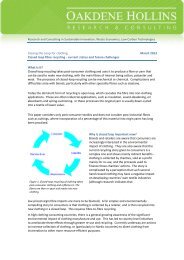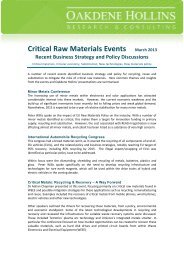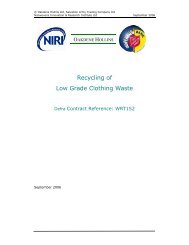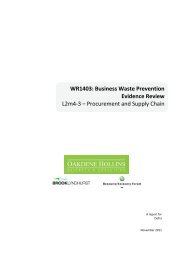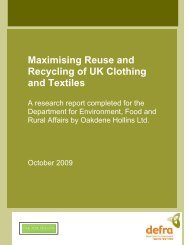Fire Retardant Technologies: safe products with ... - Oakdene Hollins
Fire Retardant Technologies: safe products with ... - Oakdene Hollins
Fire Retardant Technologies: safe products with ... - Oakdene Hollins
- No tags were found...
Create successful ePaper yourself
Turn your PDF publications into a flip-book with our unique Google optimized e-Paper software.
egarded as the standard FR chemicals, <strong>with</strong> non-chlorinated being less characterised<strong>with</strong> respect to environmental perform.Electronic Products29. Use inherently FR materials for casings and enclosuresWhile this is recommended because the use of inherent FR materials in casings andenclosures is possible, the costs may be prohibitive for the high performance polymersand composites that could be used. Other life cycle factors such as weight and totalenergy use in manufacture may also limit the use of metals.30. Phase out decaBDE/ ATO FRs in favour of phosphorus-based FRs for casings andenclosuresThe unacceptability of decaBDE on chemical hazard and risk phrase grounds, theexclusion of most PBDEs in ecolabels, and the concerns expressed about ATO, indicatethat while this is one of the best fire performing FR technologies it is one of poorestenvironmental performers. Other additive chemical FR technologies based onphosphorus based FRs which satisfy current risk phrase criteria are the best performingbut care is required to ensure that only those FRs that are chemically classified andshown to be satisfactory should be included. This may be achieved <strong>with</strong> an appropriatephase out strategy.31. Allow brominated FRs in applications where they are chemically bound to thesubstrate, for instance reactive TBBPA in printed circuit boardsFor printed circuit boards the reactive and brominated FR TBBPA satisfies the riskphrase criteria as a monomer but it should be excluded if its residual unreactedconcentration in a product fails to satisfy ecolabel criteria. The existence of inherent FRmaterials in high specification PCBs offers the best environmental performance but thecost of adopting this current technology in consumer electronic <strong>products</strong> would beprohibitive.32. Review and restrict the use of exclusions to avoid exclusion of potentially usefulchemical FRs in low hazard situationsWhile the exclusion of some brominated FRs is justified on environmental grounds, suchexclusions should not be applied to all halogenated FRs that could be used in electronicproduct applications.A number of chlorophosphorus based FRs <strong>with</strong> good low hazard environmentalperformance are available and could replace brominated FRs so these should not bearbitrarily excluded. Similarly, the same arbitrary position on excluding all brominatedFRs could exclude many of the new polymeric brominated FRs in spite of their potentiallow hazard status <strong>with</strong>in REACH and CLP.33. Ensure that alternative chemical FRs to halogenated FRs are hazard assessed andtheir classification harmonised, and risk assessed if required, to give potential usersconfidence in adopting alternatives that are known to be less hazardous than the FRsthey replace.P a g e 24 |




